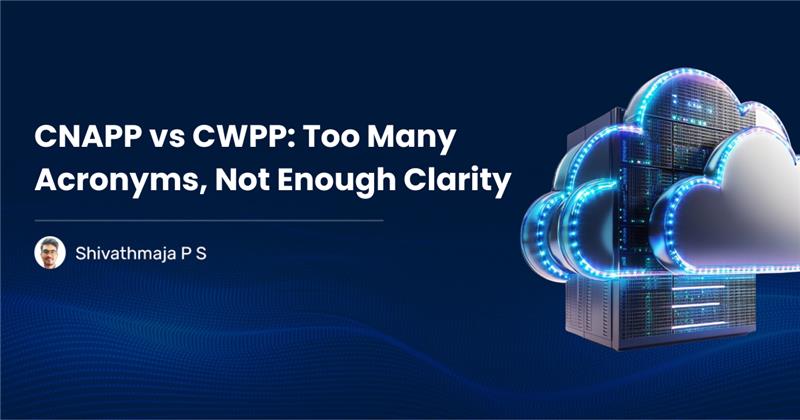How many acronyms are too many? With a new category being created seemingly every other day in cybersecurity, keeping up with it all can be exhausting. Even in the cloud security market, CNAPP, CWPP, CSPM, and other acronyms might confuse you. In this blog, let’s dig deeper into CNAPP vs CWPP, the two heavyweights in cloud security, and understand what CWPP and CNAPP tools do and why you need them for effective cloud security.
What’s CWPP (Cloud Workload Protection Platform)?
CWPPs are like security guards for your cloud-based applications and data, whether they’re running in public, private, or hybrid cloud setups. Instead of just locking down the perimeter (which isn’t always enough), these tools closely monitor your workloads in real-time. They spot suspicious behavior, block unauthorized access, and adapt security rules based on what each workload actually needs. Think of it as giving each of your cloud applications its own personalized bodyguard, making sure nothing slips through the cracks.
What CWPP does:
- Scans workloads for vulnerabilities and misconfigurations
- Offers runtime protection (e.g., anomaly detection, EDR-like behavior)
- Provides visibility into workload activity
- Controls workload, communication, and permissions
CWPP focuses on securing workloads, the actual compute layer of your cloud.
What is CNAPP (Cloud-Native Application Protection Platform)?
CNAPP is the converged platform that brings CWPP, CSPM, and more under one roof.
A Cloud-Native Application Protection Platform (CNAPP) is an all-in-one security solution designed to protect cloud-native applications throughout their entire lifecycle, from development to runtime. As more businesses move to the cloud, CNAPP addresses growing security concerns by combining multiple critical protections such as:
- CWPP for workload protection
- CSPM for cloud config checks
- CIEM (Cloud Infrastructure Entitlement Management)
Into a single platform. This unified approach not only helps security teams spot and fix risks that could lead to data breaches but also bridges the gap between security, DevOps, and development teams, especially for organizations using DevSecOps practices.
CNAPP is all about one single platform for complete cloud-native protection, from code to runtime.
A Comparative Table of Differences between CNAPP and CWPP
| Category | CNAPP (Cloud-Native Application Protection Platform) | CWPP (Cloud Workload Protection Platform) |
| Primary Objective | Unified security across cloud infrastructure, applications, identities, and data | Runtime protection of cloud workloads like VMs, containers, and serverless functions |
| Scope | CSPM, CWPP, identity management, data posture, and more. | Vulnerability and misconfiguration checks in workloads, telemetry |
| Security Layers | CSPM, CWPP, CIEM, DSPM, API security, Kubernetes security, IaC scanning | Host-based protection, malware detection, system hardening, and file integrity monitoring |
| Visibility | Holistic view of cloud risks (identity, config, data, workloads, posture) | Deep but restricted visibility into workload behavior and anomalies |
| Risk Correlation | Correlates risks across configurations, access, and workloads | Isolated to workload behavior, with limited context from the broader infrastructure |
| Use Case Fit | Cloud-native apps, multi-cloud environments, and organizations adopting zero trust | High-compliance workloads, regulated industries needing fine-grained runtime controls |
| Tool Complexity | Moderate to high: multiple tools stitched into one control plane | Moderate: focused tools for workload defense |
| Compliance Support | Includes CSPM-like checks for NIST, ISO, PCI, etc., with evidence gathering | Compliance support usually focuses on workload hardening and runtime integrity. |
| Cost Efficiency | Potentially higher ROI by reducing tool sprawl | It can become expensive if used alongside other overlapping tools |
Use CNAPP, CWPP, or Both? Decision Factors to Consider
Both platforms serve important roles, but in today’s rapidly evolving IT infrastructure, you must be prepared for everything. So, choosing the right tool and technology depends on your environment’s maturity, risk profile, and operational complexity.
Use CNAPP if you need:
- End-to-end visibility from code to runtime
- Risk correlation across config, access, and workloads
- Security integration into CI/CD pipelines
Use CWPP if you need:
- Deep runtime control and telemetry
- Protection in regulated infrastructure environments
- Simpler workload defense for legacy VMs
But CNAPP today has evolved and absorbed CWPP under its belt, and most modern CNAPP tools can be used to for comprehensive workload protection.
Conclusion
CNAPP and CWPP are absolute essentials in your cloud security stack. With threat actors rapidly evolving and trying to find ingenious ways to breach your network, complete protection is a must.
Picking the right tool will make or break your security posture and might be the last defense against cyberattackers. Ensure your CNAPP tools include CWPP capabilities or if you need to buy one!


